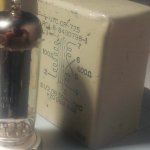For nearly any home audio application, high input impedance/low output impedance is standard. For an input transformer for a normal tube preamp, the JT-11P1 is an excellent choice. The loading on the secondary is critical, though- you'll want to follow the Jensen app note suggestions. A series RC network across the secondary will often clean up a bit of ringing that Miller capacitance can cause.
Hi guys
I am wondering how to use the 600:600 for eg. Jensen 11ssp8ma and 10k:10k 11p1 Jensen transformer
How do I determine which is high or low impedance circuit?
For eg. The input of #26 single ended preamp. Are they low or high impedance circuit?
Thanks in adv
Erwin
This is a question that comes up all the time. If you consider the theory of mutual inductance, what you find is that under conditions of loose coupling that what you hang on the secondary has little effect on what happens at the primary, since the jwM is so small.
Even if the coupling is tight, the same applies if the secondary load is much larger than jwM, and it will likewise have little effect since the current is quite low, even if the voltage is large due to a bigger jwM term.
In either case, a 600 : 600, or a 10K : 10K interstage, you have a 1 : 1 voltage ratio, and the xfmr is acting simply as a buffer, usually in order to break up a ground loop by means of electromagnetic isolation.
What the impedances do tell you is what sort of frequency behaviour you can expect. A 600 : 600 will have less inductance, and will have poorer low frequency response if connected to higher than a 600R load. For broadband xfmrs, the Xl of the primary should be ~4 -- 5 times the resistance connected to it. At the very least, Xl should be equal to Ri; more would be better, but it's a good deal more difficult to make Xl= Ri at 20Hz than it is at 2.0MHz. RF xfmrs are a good deal easier to make than AF xfmrs.
"The input of #26 single ended preamp. Are they low or high impedance circuit?"
If connected grounded cathode, it's a very high impedance load. If connected grounded grid, a much lower impedance load. If connected GK, then the xfmr you choose will be determined by the source impedance. If connected to a Lo-Z source, you'd prefer the 600R xfmr. If it's a Hi-Z source, then you'll get better performance from the 10K IST.
Hi guys
Please pardon my ignorant. What's "jwM" and "connected GK' means in Miles post. Thanks
Erwin
j= sqrt(-1)
w= 2 X pi X f (radians/sec) angular frequency
M: Mutual inductance
M= k X sqrt(Lpri X Lsec) (k: coupling coefficient)
GK: Grounded Cathode
Bumping up old thread so i don't clutter this forum with new one.
See the attached (input/interstage?) transformer from UTC that i have. I want to use it as input transformer. It's for a push-pull bass guitar amplifier so it doesn't have to be hifi. Seeing that it's already center-tapped, can i use this as input+splitting transformer which goes to a pair 12AX7 having 1M grid resistors? i.e from the bass pickup coil, signal goes to the 100R input and 600R output goes to 12AX7.
See the attached (input/interstage?) transformer from UTC that i have. I want to use it as input transformer. It's for a push-pull bass guitar amplifier so it doesn't have to be hifi. Seeing that it's already center-tapped, can i use this as input+splitting transformer which goes to a pair 12AX7 having 1M grid resistors? i.e from the bass pickup coil, signal goes to the 100R input and 600R output goes to 12AX7.
In this case, i believe the load is approximately 1M (12AX7 grid resistor) so i guess i will lose low frequencies?A 600 : 600 will have less inductance, and will have poorer low frequency response if connected to higher than a 600R load.
Attachments
Last edited:
I think i get it..
600R impedance have lower inductance than 10K (simply because it has less winding) so when connected to 1M resistor, i will lose low frequencies because i'm making shunt LR network having low L inductance.. so at low frequencies, the L part is like a short circuit to ground (no signal going to tube grid). Did i get it right?
600R impedance have lower inductance than 10K (simply because it has less winding) so when connected to 1M resistor, i will lose low frequencies because i'm making shunt LR network having low L inductance.. so at low frequencies, the L part is like a short circuit to ground (no signal going to tube grid). Did i get it right?
Wait.. my conclusion doesn't sound right.
Low-z output (600R) coupled to High-Z input (1M) is favorable, isn't it?
So, the problem is how to drive the low impedance primary (100R).
That 12AX7 will be Grounded Cathode so it's only a matter of my 100R primary driver, right?
Low-z output (600R) coupled to High-Z input (1M) is favorable, isn't it?
So, the problem is how to drive the low impedance primary (100R).
If connected GK, then the xfmr you choose will be determined by the source impedance. If connected to a Lo-Z source, you'd prefer the 600R xfmr. If it's a Hi-Z source, then you'll get better performance from the 10K IST.
That 12AX7 will be Grounded Cathode so it's only a matter of my 100R primary driver, right?
- Status
- This old topic is closed. If you want to reopen this topic, contact a moderator using the "Report Post" button.
- Home
- Amplifiers
- Tubes / Valves
- input transformer and impedance question
